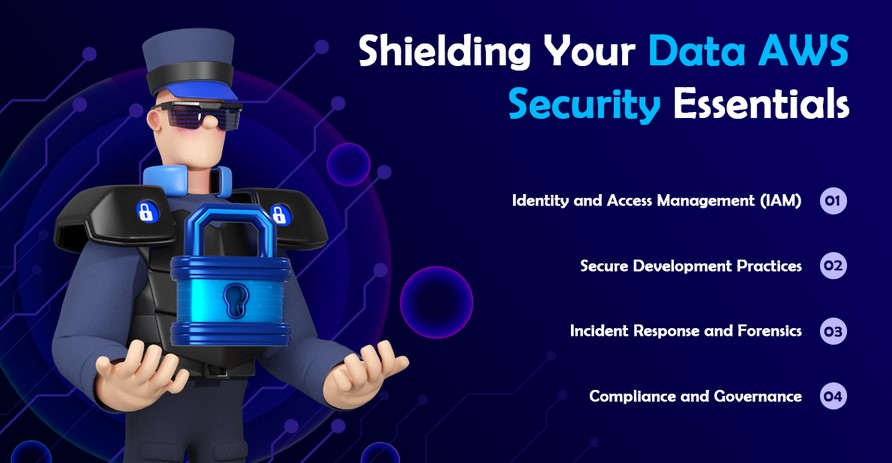
In the world of cloud computing, data security is paramount. According to Ezops Cloud when it comes to Amazon Web Services (AWS), safeguarding your information is vital for protecting your business and your customers. This article explores essential data security best practices tailored for AWS users. From understanding built-in security features to implementing encryption and monitoring, we’ll cover everything you need to know to keep your data safe in the AWS cloud. Let’s dive in and ensure your data stays secure every step of the way.
Understanding AWS Security Features:
AWS offers a range of security features to safeguard your data and resources in the cloud. Understanding these features is essential for ensuring the integrity and confidentiality of your information.
Identity and Access Management (IAM):
With IAM, you can safely control user access to AWS services. Set up and maintain users and groups, limit access to resources, and assign permissions.
Encryption:
To safeguard your data, AWS offers encryption both in transit and at rest. For data security, use services such as AWS Key Management Service (KMS) to manage encryption keys.
Network Security:
Control access to your AWS resources by configuring security groups and network access control lists (ACLs). Utilize the AWS Virtual Private Cloud (VPC) to isolate your resources and establish secure communication channels.

Implement and Enforce Cloud Security Controls
It is your responsibility, not AWS’s, to safeguard your cloud workloads. Keep that in mind. This implies that it is your responsibility to set up strong safeguards to guarantee that client and business data is protected from harmful attacks.
To reduce the chance of data breaches, take into account these cloud security measures and protocols:
Clearly specify the roles of users: Avoid giving users more or unnecessary access by only granting them the minimal amount of privileges needed to complete their tasks.
Perform privilege audits: By comparing user privileges with current or ongoing assignments, audits can be used to regularly review and revoke privileges that are no longer needed.
Adopt a strong password policy: You should mandate the use of both expiration dates and strong passwords. Set password expiration dates in accordance with your company’s policy and enforce the use of strong passwords.
Make use of permission time-outs and multifactor authentication. These measures provide an additional degree of security by making it more difficult for unauthorised individuals to access accounts in your Amazon environment.
Make Your AWS Security Policies Accessible
The key to successfully implementing a cybersecurity strategy is making sure that everyone is in agreement. Make sure that everyone in your company, including stakeholders, outside partners, and outside vendors, has easy access to a copy of the document that outlines your security policies and controls. Store it on an internal drive.
Treating your security strategy as a dynamic, living document is essential. Make sure to update it frequently to keep up with the rapidly changing technological landscape. New potential risks and vulnerabilities arise with technological advancements, requiring you to modify your policies in order to maintain an effective posture.
Backup Your Data
Experts of Ezops Cloud say you never know if you will need to restore data after a breach, so back up your data regularly. A simple solution for automating backups throughout your AWS environment, alleviates concerns about potential data loss and ensures and seamless restoration when needed.
Do not forget to activate multifactor authentication. To delete or change a bucket’s versioning state in S3, users must provide two different forms of authentication.
Update Your Amazon System
You must always keep your AWS cloud servers patched, even if they are not visible to the general public. Maintaining patch levels on your AWS cloud servers is essential, even if they are private servers. Even for the AWS cloud . You run the risk of numerous security flaws if you do not update your cloud infrastructure, which can lead to expensive and inconvenient events for your company.
Fortunately, you have a few options at your disposal to make patching your AWS servers easier. You can leverage third-party tools designed specifically for patching AWS servers, which makes it easy to automate patches for your cloud systems. Keeping up to date with updates your security posture and guard you against potential risks.
An Improved Approach to Protect Your AWS Environment
Cloud security seems like a completely different game if you are used to protecting on-premises environments. You can keep up with the rapid pace of cloud-based development with the aid of these nine AWS security best practices. However, a native solution that can defend your AWS deployments from hostile parties is still required.
Wrapping Up:
Ezops Cloud came to the conclusion that protecting your data on AWS is essential for the security of your company and client data. By implementing the outlined best practices, including IAM, encryption, and network security, you can mitigate risks and ensure data integrity. Remember, it’s your responsibility to enforce robust security controls and keep your AWS systems up to date to stay ahead of potential threats. Stay vigilant and prioritize data security in your AWS environment for long-term success.

